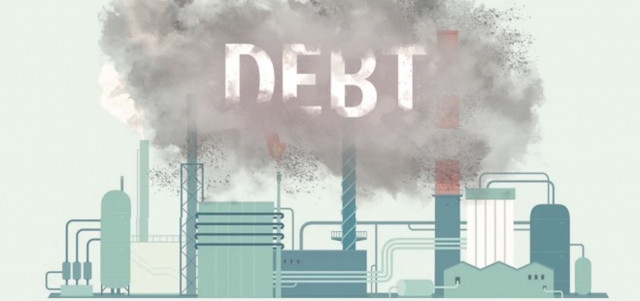Per person debt jumps by 21%
Every citizen of Pakistan has Rs216,708 debt burden, blamed on wrong policies

The debt burden of every citizen alarmingly jumped by 21% to Rs216,708 by the end of previous fiscal year due to wrong economic policies, stated an annual report of the Ministry of Finance, admitting that the previous year’s fiscal policies sowed seeds of economic instability. The Fiscal Policy Statement 2022-23 has been prepared to meet a statutory requirement, a document that had been conceived 18 years ago to inform the National Assembly about the true state of economy.
The policy statement showed that per person debt burden increased from Rs179,100 in June 2021 to Rs216,708 by June 2022. There was an additional liability of Rs37,608, or 21%, on every citizen in just one year. Pakistan Tehreek-e-Insaf (PTI) had been in power in the first nine months of previous fiscal year, ie 2021-22, while in the last quarter, Pakistan Democratic Movement (PDM) was at the helm of affairs. The report, which has not yet been made public, is expected to be laid before NA next week to meet requirements of the Fiscal Responsibility and Debt Limitation Act of 2005.
Gross public debt jumped to Rs49.2 trillion by June 2022, which has now increased further. Over one-fifth increase in per capita debt in one year indicates the speed at which the country is sinking under the debt burden. The Ministry of Finance has worked out the per capita debt on the assumption of a population of 227 million people. The report mentioned that fiscal year 2021-22 steered the economy to a growth of 6%. “This growth could have been more sustainable, if led by investment rather than consumption,” said the finance ministry.
The unproductive nature of growth made the country susceptible to unfavourable domestic and global economic shocks, stated the report. “The sharp (V-shaped) economic recovery after control over Covid-19, coupled with the international market dynamics in response to the Russia-Ukraine conflict, has put the country into a crisis in terms of high fiscal deficit,” said the policy statement. Ironically, the Ministry of Finance’s reports in the PTI era were full of praise for the V-shaped economic recovery, a phrase used to describe a quick economic rebound after the damage from the coronavirus pandemic.
The Ministry of Finance had to give two different opinions on one issue in a single year, which underscores its professional advice should not be influenced by the government of the day. While criticising the previous fiscal year’s policies, the ministry stated that a prudent fiscal policy, accompanied by the correct stance of monetary policy, was required to rationalise demand and improve production base, prioritising improving the fiscal and current account deficit. The report noted that “political uncertainty has shattered the confidence of stakeholders in the economy”.
The previous government missed last fiscal year’s annual budget deficit target of Rs3.4 trillion and the actual deficit came in at Rs5.3 trillion, the record deficit in a fiscal year. In terms of the size of economy, the total fiscal deficit was equal to 7.9% of GDP, whereas the primary deficit remained at 3.1%. Actual non-tax revenue in the last fiscal year stood at Rs1.3 trillion against the budgetary target of Rs2.3 trillion, according to the ministry, a reduction of 46%.
Petroleum levy fell short of the collection target by Rs483 billion due to the previous government’s decision to lower taxes. The finance ministry said that the gas infrastructure development surcharge missed the collection target by Rs111 billion and profits of the State Bank of Pakistan fell Rs176 billion below the budgetary target. There were huge slippages in the budgetary target of Rs682 billion for subsidies. Actual subsidies remained at Rs1.529 trillion, about 232% more than the budgeted amount.
The main reason for slippages was the Ministry of Finance’s unrealistic budgeting coupled with reduction in prices of electricity and petrol by former prime minister Imran Khan. The budget estimate for energy subsidies was Rs622 billion, with Rs596 billion for the power sector and Rs20 billion for the petroleum sector. However, the actual expenditure on energy subsidies rose to Rs1.44 trillion, the report stated. The cost of former prime minister’s politically motivated relief package was Rs241.4 billion.
All meetings for devising the relief package were held in the Ministry of Finance. Neither former finance minister Shaukat Tarin nor Q-block bureaucracy could say “NO” to the irrational decision-making. The finance ministry stated that the “expansionary fiscal policy stance in fiscal year 2021- 22 reversed the consolidation gains achieved in the preceding two years”.
“Prioritising economic growth at the cost of a higher fiscal deficit created a problematic fiscal situation”, mentioned the report. Although the ministry is putting blame on the previous government, it has not uttered a word on today’s fiscally unsustainable initiatives like the parliamentarians’ schemes and the PM’s initiatives in areas that fall within the provincial domain.



















COMMENTS
Comments are moderated and generally will be posted if they are on-topic and not abusive.
For more information, please see our Comments FAQ